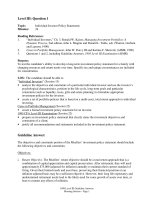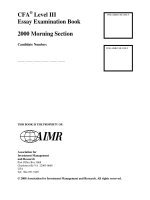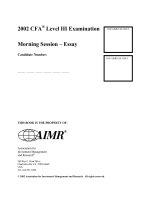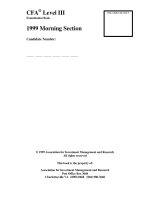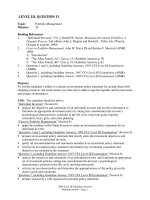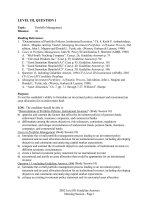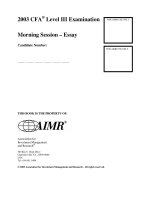CFA institutie 2008 sample exam 01
Bạn đang xem bản rút gọn của tài liệu. Xem và tải ngay bản đầy đủ của tài liệu tại đây (806.83 KB, 122 trang )
CFA Institute 2008 Sample Exam 01
Q1 – Q6
Theresa Lecompte Case Scenario
Theresa Lecompte, CFA, is an equity analyst for Topaz Group, a large financial firm that offers investment banking,
brokerage, and investment management services. Topaz has adopted the CFA Institute Research Objectivity
Standards to demonstrate their commitment to managing and fully disclosing conflicts of interest to all investors that
have access to the firm's research.
Lecompte's primary responsibility is to follow the information technology sector for the firm's research department.
She is working on two follow-up reports for NanoMem (NM) and UniFlash (UF). Topaz makes markets in both
companies' securities and Lecompte owns a small position in NM only.
Lecompte has an excellent relationship with company officials at NanoMem. In appreciation for Lecompte's favorable
recommendations in the past, she was invited to attend a company-sponsored event last December that was held at
an exclusive ski resort overseas. NanoMem paid all expenses relating to the trip and provided some excellent
entertainment activities for the attendees. Lecompte disclosed this benefit to her supervisor at Topaz. Shortly
thereafter, Topaz issued a secondary offering for NM. Lecompte believes that her excellent relationship with the firm
played a large part in securing this business.
Lecompte considers her relationship with UniFlash, however, to be contentious, as company officials seem reluctant
to share as much information with her as they have in the past. She believes the change in their behavior is a direct
result of recent reports she has written on the company, which have been less than favorable. Prior to publication of
her follow-up reports, Lecompte shares her report on NM in its entirety with top management at NanoMem. She
shares only the part of her report on UF that provides factual information with UniFlash management.
Lecompte's compensation at Topaz includes an annual salary plus a bonus based on both the accuracy of her
recommendations over time and the overall profitability of the company. Topaz makes public disclosure of the extent
to which research analyst compensation in general is dependent upon the firm's investment banking revenues.
Following the release of her reports in early March, Lecompte is invited to appear on a television program to discuss
her recommendations. During her appearance, she makes the following statements:
1. "My firm makes markets in the securities of both NanoMem and UniFlash and I currently own a position in
NanoMem."
2.
"Although I just issued a report on UniFlash that reflected a neutral rating, I really believe a sell rating is more
appropriate."
When she returns to her office the following day, Lecompte is informed by her supervisor that a company official at
UniFlash called to express his disappointment and anger in hearing the negative remarks she had made about UF
during her television appearance. Lecompte states that she believes her deteriorating relationship with UniFlash will
make it difficult to effectively cover the company in the future and recommends that Topaz discontinue coverage of
UF immediately.
Question
In sharing her research material with the subject companies, has Lecompte violated any CFA Institute Research
Objectivity Standards with respect to her report on:
NanoMem?
UniFlash?
A.
No
No
B.
No
Yes
C.
Yes
No
D.
Yes
Yes
Select exactly 1 answer(s) from the following:
A. Answer A
B. Answer B
C. Answer C
D. Answer D
Correct answer = C
"CFA Institute Research Objectivity Standards" (AIMR, 2003; adapted 2005)
2008 Modular Level II, Vol. 1, Reading 4, pp. 146, 150-151
Study Session 1-4-b
critique company policies and practices related to research objectivity and distinguish between changes required and
changes recommended for compliance with the Research Objectivity Standards
Lecompte violated the Standards in sharing the full report with NanoMem. Sharing any section of a research report that
might communicate the analyst's proposed recommendation, rating, or price target is prohibited by the Standards. She did
not violate the Standards in sharing only those portions of the report containing facts that could be reasonably checked or
verified by UniFlash prior to publication.
Question
With respect to the company-sponsored event that Lecompte attended, did she violate any CFA Institute Standards?
Select exactly 1 answer(s) from the following:
A. Yes.
B. No, because she disclosed it to her employer.
C. No, because the Standards do not prohibit ordinary, business-related entertainment.
D. No, because maintaining appropriate working relationships with subject-company personnel is an
important part of her responsibilities.
Correct answer = A
Standards of Practice Handbook, 9th edition (CFA Institute, 2005), pp. 19-21
Standards I-VII
2008 Modular Level II, Vol. 1, Reading 2, pp. 21, 23-24
"CFA Institute Research Objectivity Standards" (AIMR, 2003; adapted 2005)
2008 Modular Level II, Vol. 1, Reading 4, p. 150
Study Session 1-2-a, 1-4-b
demonstrate a thorough knowledge of the Code of Ethics and Standards of Professional Conduct by applying the Code and
Standards to specific situations;
critique company policies and practices related to research objectivity and distinguish between changes required and
changes recommended for compliance with the Research Objectivity Standards
Lecompte violated both the CFA Institute Standard relating to independence and objectivity and the CFA Institute Research
Objectivity Standards by allowing a corporate issuer to pay for her travel expenses.
Question
Regarding Lecompte's compensation structure, is Topaz in violation of the CFA Institute Research Objectivity Standards
with respect to the:
accuracy of her
overall profitability
recommendations?
of the firm?
A.
No
No
B.
No
Yes
C.
Yes
No
D.
Yes
Yes
Select exactly 1 answer(s) from the following:
A. Answer A
B. Answer B
C. Answer C
D. Answer D
Correct answer = A
"CFA Institute Research Objectivity Standards" (AIMR, 2003; adapted 2005)
2008 Modular Level II, Vol. 1, Reading 4, pp. 146, 149
Study Session 1-4-b
critique company policies and practices related to research objectivity and distinguish between changes required and
changes recommended for compliance with the Research Objectivity Standards
The Research Objectivity Standards recommend that analyst compensation be based on the accuracy of recommendations
over time. Although direct linking of an analyst's compensation with investment banking is prohibited, firms should disclose
the extent to which research analyst compensation in general is dependent upon the firm's investment banking revenues,
which they do.
Question
According to the CFA Institute Research Objectivity Standards, does the first statement Lecompte makes in her television
appearance provide all the recommended disclosures relating to potential conflicts of interest with respect to:
NanoMem?
UniFlash?
A.
No
No
B.
No
Yes
C.
Yes
No
D.
Yes
Yes
Select exactly 1 answer(s) from the following:
A. Answer A
B. Answer B
C. Answer C
D. Answer D
Correct answer = B
"CFA Institute Research Objectivity Standards" (AIMR, 2003; adapted 2005)
2008 Modular Level II, Vol. 1, Reading 4, pp. 145, 148
Study Session 1-4-b
critique company policies and practices related to research objectivity and distinguish between changes required and
changes recommended for compliance with the Research Objectivity Standards
Because she failed to disclose the investment banking relationship that Topaz had with NanoMem, Lecompte did not provide
all the recommended disclosures relating to potential conflicts of interest with respect to NanoMem. Lecompte did provide
all the recommended disclosures relating to potential conflicts of interest with respect to UniFlash.
Question
According to the recommended procedures for compliance with the CFA Institute Research Objectivity Standards,
Lecompte's second statement during her TV appearance:
Select exactly 1 answer(s) from the following:
A. complies, because she communicated her most current opinion.
B. complies, because she disclosed all conflicts of interest with respect to the company.
C. does not comply, because she failed to identify the relevant benchmark for the rating category.
D. does not comply, because she communicated a rating that is different from her current published
rating.
Correct answer = D
"CFA Institute Research Objectivity Standards" (AIMR, 2003; adapted 2005)
2008 Modular Level II, Vol. 1, Reading 4, p. 153
Study Session 1-4-b
critique company policies and practices related to research objectivity and distinguish between changes required and
changes recommended for compliance with the Research Objectivity Standards
The recommended procedures for compliance with the CFA Institute Research Objectivity Standards states that firms
should prohibit covered employees from communicating a rating or recommendation that is different from the current
published rating or recommendation.
Question
With respect to Lecompte's recommendation on the coverage of UniFlash, according to the CFA Institute Research
Objectivity Standards, the most appropriate course of action for Topaz to take would be to:
Select exactly 1 answer(s) from the following:
A. issue a final report on UniFlash.
B. quietly and unobtrusively discontinue coverage of UniFlash.
C. immediately disclose on their website the company's intention to discontinue coverage of UniFlash.
D. encourage another analyst to develop an appropriate relationship with UniFlash by issuing a more
favorable recommendation.
Correct answer = A
"CFA Institute Research Objectivity Standards" (AIMR, 2003; adapted 2005)
2008 Modular Level II, Vol. 1, Reading 4, p. 151
Study Session 1-4-b
critique company policies and practices related to research objectivity and distinguish between changes required and
changes recommended for compliance with the Research Objectivity Standards
According to the CFA Institute Research Objectivity Standards, when coverage of a subject company is being discontinued,
firms should require the research analyst to issue a "final" research report that includes a recommendation.
Q7 – Q12
Rhonda Hamilton Case Scenario
Rhonda Hamilton, CFA, manages the Select Electric Fund. Hamilton is reviewing a research report written by Brian
Ender about the U.S. electric utility industry. Ender’s report includes the regression model and relevant statistics
presented in Exhibit 1. The dependent variable for the model is the monthly return for an electric utility equity index
for the previous 158 months. The independent variables are the monthly returns for the Standard & Poor's 500
(S&P500) and the difference between the monthly returns on long-term U.S. government bonds and one-month U.S.
Treasury bills (SPREAD). All variables are recorded in percent.
Exhibit 1
Ender's Regression Model
Electric Utility Industry
Variable
Coefficient
t-statistic
p-value
Constant
-0.0069
-0.018
0.98
S&P500
0.3625
4.240
<0.01
SPREAD
1.0264
7.480
<0.01
R2
=
0.40
Durbin-Watson Statistic
=
0.84
F-value (2, 155)
=
51.40
Standard Error of Estimate
=
4.50
Ender’s report concludes that the model is well-specified because its explanatory power is good. The report also contains
a footnote indicating that confidence intervals for predicted utility equity returns can be easily computed using only the
standard error of estimate.
Hamilton agrees that S&P500 and SPREAD are reasonable independent variables, but she is not convinced by Ender’s
conclusions. Using Ender's data, Hamilton tested for and confirmed the presence of conditional heteroskedasticity. She
then ran a regression similar to that run by Ender and corrected for conditional heteroskedasticity using robust standard
errors (i.e., Hansen’s method). Hamilton’s regression model and relevant statistics are presented in Exhibit 2.
Exhibit 2
Hamilton's Regression Model
Electric Utility Industry
Variable
Coefficient
t-statistic
p-value
Constant
-0.0069
-0.013
.099
S&P500
0.3625
6.190
<0.01
SPREAD
1.0264
4.280
<0.01
R2
=
0.40
Durbin-Watson Statistic
=
0.84
Correlaton between SPREAD and S&P500
=
0.30
Hamilton hypothesizes that the returns for the electric utility equity index have a sensitivity coefficient to bond yields (i.e.,
SPREAD) equal to one. She is also interested in the precision of the sensitivity of electric utility equity returns to S&P500.
Hamilton wants to use the regression results to address both of these issues. Selected values of the t-distribution are
shown in Exhibit 3.
Exhibit 3
Selected Values of the t-Distribution
(degrees of freedom = df, one-tailed probabilities = p)
df
p=0.05
p=0.025
100
1.660
1.984
110
1.659
1.982
120
1.658
1.980
200
1.653
1.972
∞
1.645
1.960
Question
Given Hamilton's finding regarding heteroskedasticity, the most appropriate conclusion is that the variance of the
error term is:
Select exactly 1 answer(s) from the following:
A. correlated with the values of the dependent variable.
B. correlated with the values of the independent variables.
C. not correlated with the values of the dependent variable.
D. not correlated with the values of the independent variables.
Correct answer = B
"Multiple Regression and Issues in Regression Analysis," Richard A. DeFusco, Dennis W. McLeavey, Jerald E. Pinto, and
David E. Runkel
2008 Modular Level II, Vol. 1, pp. 293-296
Study Session 3-12-g
discuss the types of heteroskedasticity and the effects of heteroskedasticity and serial correlation on statistical inference
Hamilton's test confirmed the presence of conditional heteroskedasticity, which means that the variance of the error term
is correlated with the values of the independent variables.
Question
If Hamilton assumes that the monthly values for both SPREAD and S&P500 are 1%, the predicted monthly return for
the electric utility equity index is closest to:
Select exactly 1 answer(s) from the following:
A. 0.36%.
B. 1.00%.
C. 1.03%.
D. 1.38%.
Correct answer = D
"Multiple Regression and Issues in Regression Analysis," Richard A. DeFusco, Dennis W. McLeavey, Jerald E. Pinto, and
David E. Runkel
2008 Modular Level II, Vol. 1, pp. 283-285
Study Session 3-12-c
calculate and interpret 1) a confidence interval for the population value of a regression coefficient and 2) a predicted value
for the dependent variable, given an estimated regression model and assumed values for the independent variables
Substituting the assumed values into the estimated model results in the following:
Monthly return = -0.0069% + 1.0264(1%) + 0.3625(1%) = 1.38%.
Question
In assessing how well her regression model explains electric utility equity index returns, Hamilton's most appropriate
conclusion is that:
Select exactly 1 answer(s) from the following:
A. 16% of the variation in index returns is explained by the regression model.
B. 36% of the variation in index returns is explained by the regression model.
C. 40% of the variation in index returns is not explained by the regression model.
D. 60% of the variation in index returns is not explained by the regression model.
Correct answer = D
"Multiple Regression and Issues in Regression Analysis," Richard A. DeFusco, Dennis W. McLeavey, Jerald E. Pinto, and
David E. Runkel
2008 Modular Level II, Vol. 1, pp. 287-288
Study Session 3-12-e
calculate and interpret the F-statistic, and discuss how it is used in regression analysis, define, distinguish between, and
interpret the R2 and adjusted R2 in multiple regression, and infer how well a regression model explains the dependent
variable by analyzing the output of the regression equation and an ANOVA table
Because the explained variation or R2 = 40%, then the unexplained variation is (1 - 40%) = 60%.
Question
Based on the results in Exhibit 2, the value of the test statistic relating to Hamilton's null hypothesis about the value
of the sensitivity coefficient to SPREAD is closest to:
Select exactly 1 answer(s) from the following:
A. 0.11.
B. 0.24.
C. 4.17.
D. 4.28.
Correct answer = A
"Multiple Regression and Issues in Regression Analysis," Richard A. DeFusco, Dennis W. McLeavey, Jerald E. Pinto, and
David E. Runkel
2008 Modular Level II, Vol. 1, pp. 281-283
Study Session 3-12-b
formulate a null and an alternative hypothesis about the population value of a regression coefficient, calculate the value of
the test statistic, determine whether to reject the null hypothesis at a given level of significance, using a one-tailed or
two-tailed test, and interpret the result of the test
The null hypothesis is H0: bspread = 1. The calculated value of the t-statistic is t = (1.0264 - 1.0) / standard error. The
standard error is 1.0264 / 4.28 = 0.24. The calculated value for t = (1.0264 - 1.0) / 0.24 = 0.11.
Question
Based on the results in Exhibit 2, if degrees of freedom = 200, the 95% confidence interval for the sensitivity of
electric utility equity index returns to S&P500 is closest to:
Select exactly 1 answer(s) from the following:
A. 0.19 to 0.53.
B. 0.22 to 0.50.
C. 0.25 to 0.48.
D. 0.27 to 0.46.
Correct answer = C
"Correlation and Regression," Richard A. DeFusco, Dennis W. McLeavey, Jerald E. Pinto, and David E. Runkel
2008 Modular Level II, Vol. 1, pp. 240-248
Study Session 3-11-f
calculate and interpret the standard error of estimate, the coefficient of determination, and a confidence interval for a
regression coefficient
The standard error is found in Exhibit 2 as follows: t-statistic = 6.19 = 0.3625 / standard error. The standard error = 0.0586.
The two-tailed critical t-value (1.972) is taken from the table with p = 0.025. The confidence interval is 0.3625 ± 1.972 x
0.0586, or 0.25 to 0.48.
Question
Because there are only two independent variables in her regression, Hamilton's most appropriate conclusion is that
multicollinearity is NOT a problem, based on the observation that the:
Select exactly 1 answer(s) from the following:
A. model R2 is relatively low.
B. correlation between S&P500 and SPREAD is low.
C. method used for the results in Exhibit 4 also corrects for multicollinearity.
D. model F-value is high and the p-values for S&P500 and SPREAD are low.
Correct answer = B
"Multiple Regression and Issues in Regression Analysis," Richard A. DeFusco, Dennis W. McLeavey, Jerald E. Pinto, and
David E. Runkel
2008 Modular Level II, Vol. 1, pp. 304-307
Study Session 3-12-h
describe multicollinearity and discuss its causes and effects in regression analysis
Multicollinearity arises from a high correlation among the independent variables. In Hamilton's regression model, the
correlation between the SPREAD and the S&P500 variables is only 0.30.
Q13 – Q18
Renaud Blanc Case Scenario
Renaud Blanc is an analyst in the risk management department of De Luca Corporation, a U.S. company that
processes fruit and vegetables bought on the world market. Production and sales of packaged fruit juices and
condiments occur in the United States, South America, and Europe. Blanc is responsible for making assessments of
the relative strength of the U.S. dollar against other relevant currencies. Blanc knows that relative rates of inflation
will influence the dollar value of a currency, so he forecasts inflation for the United States and its trading partners.
De Luca buys fruit from Brazil. For the coming year Blanc forecasts annual U.S. inflation of 2% and annual Brazilian
inflation of 10%. The current exchange rate is BRL3/USD (BRL = Brazilian real, USD = U.S. dollar). The one-year
risk-free interest rates in the United States and Brazil are 2.25% and 18%, respectively.
One of Blanc’s colleagues, Paula Smith, makes the following statements:
1. "The theory of uncovered interest rate parity allows me to calculate E(S1)/S0 as being equal to the ratio of "one
plus the one-year Brazilian interest rate” to "one plus the one-year U.S. interest rate,” when the expected ending
exchange rate, E(S1), and the beginning of period exchange rate, S0, are quoted as BRL/USD.”
2. "Exchange rate risk reduces to inflation uncertainty if all parity relationships hold perfectly.”
Smith questions Blanc about whether forward markets for the Brazilian real give any indication about the expected
exchange rate in one year. Blanc responds:
"If the forward rate equals the expected spot rate, then using forward currency contracts to hedge exchange risk
would be costless (aside from commissions) in terms of the expected dollar price that De Luca would pay for fruit in
Brazil.”
De Luca also purchases fruit and packaging materials in Europe. Blanc is considering various ways to hedge against
the cost of future material purchases in Europe. For the coming year, he forecasts annual inflation of 4% for Europe
and 2% for the United States. He believes that uncovered and covered interest parity hold for the United States and
Europe.
Question
Based on purchasing power parity, Blanc's estimate of the exchange rate (BRL / USD) in one year should be closest
to:
Select exactly 1 answer(s) from the following:
A. 2.60.
B. 2.78.
C. 3.24.
D. 3.46.
Correct answer = C
"Foreign Exchange Parity Relations," Bruno Solnik and Dennis McLeavey
2008 Modular Level II, Vol. 1, pp. 562-564
Study Session 4-19-g
discuss absolute purchasing power parity and relative purchasing power parity and calculate the end-of-period exchange
rate implied by purchasing power parity, given the beginning-of-period exchange rate and the inflation rates
Based on relative PPP we have S1 = S0 x (1+ IBRL) / (1+IUS) where the exchange rate, S, is quoted as BRL / USD, and I is
inflation. We have e1 = BRL3 / USD x (1.10) / (1.02) = 3.235 = 3.24. The approximate version of PPP would indicate that
the percentage change in the exchange rate would be 10% - 2% = 8% for a new exchange rate of 3 x 1.08 = BRL3.24 /
USD.
Question
Based on interest rate parity, Blanc's estimate of the one-year forward exchange rate for the Brazilian real (BRL /
USD) should be closest to:
Select exactly 1 answer(s) from the following:
A. 2.60.
B. 2.78.
C. 3.47.
D. 3.62.
Correct answer = C
"Foreign Exchange Parity Relations," Bruno Solnik and Dennis McLeavey
2008 Modular Level II, Vol. 1, pp. 561-562
Study Session 4-19-k
calculate the forward exchange rate, given the spot exchange rate and risk-free interest rates, using 1) interest rate parity,
and 2) its linear approximation
The correct use of interest rate parity is as follows:
F = S0 x (1+ rBRL) / (1+ rUS), where r is the interest rate, and the exchange rate, S0, and the forward rate, F, are quoted as
BRL / USD. We have F = 3 x (1.18) / (1.0225) = 3.462. The approximate forward premium / discount (equation 19.1) is
equal to 18% - 2.25% = 15.75% for a forward rate of 3 x (1+ 0.1575) = 3.4725.
Question
Is Smith's statement about the theory of uncovered interest rate parity correct?
Select exactly 1 answer(s) from the following:
A. Yes.
B. No, because the relationship is covered interest parity.
C. No, because the relationship is relative purchasing power parity.
D. No, because the relationship is absolute purchasing power parity.
Correct answer = A
"Foreign Exchange Parity Relations," Bruno Solnik and Dennis McLeavey
2008 Modular Level II, Vol. 1, pp. 566-568
Study Session 4-19-h, i
discuss the international Fisher relation and calculate and interpret 1) interest rates exactly and by linear approximation,
given expected inflation rates and the assumption that the international Fisher relation holds, 2) the real interest rate, given
interest rates and inflation rates and the assumption that the international Fisher relation holds, and 3) the international
Fisher relation, and its linear approximation, between interest rates and expected inflation rates;
discuss the theory of uncovered interest rate parity, and explain the theory's relationship to other exchange rate parity
theories and calculate and interpret the expected change in the exchange rate, given interest rates and the assumption that
uncovered interest rate parity holds
In the vignette, note 1 indicates that E(S1) / S0 is equal to the ratio of "one plus the Brazilian rate" to "one plus the U.S. rate"
(with S quoted at BRL / USD). This is a correct statement of uncovered interest rate parity.
Question
Blanc's best response to Smith's statement about exchange rate risk is that the statement is:
Select exactly 1 answer(s) from the following:
A. correct.
B. incorrect, because exchange rate risk reduces to real rate uncertainty.
C. incorrect, because exchange rate risk reduces to interest rate uncertainty.
D. incorrect, because exchange rate risk is eliminated if all parity relationships hold.
Correct answer = A
"Foreign Exchange Parity Relations," Bruno Solnik and Dennis McLeavey
2008 Modular Level II, Vol. 1, pp. 569-571
Study Session 4-19-l
discuss the implication of the parity relationships combined
If all parity conditions hold simultaneously, then nominal exchange risk will be eliminated but we are still confronted with
inflation uncertainty.
Question
Is Blanc's response to Smith about the forward rate and using forward currency contracts correct?
Select exactly 1 answer(s) from the following:
A. Yes.
B. No, because uncovered interest parity must also hold.
C. No, because the international Fisher effect must also hold.
D. No, because relative purchasing power parity must also hold.
Correct answer = A
"Foreign Exchange Parity Relations," Bruno Solnik and Dennis McLeavey
2008 Modular Level II, Vol. 1, pp. 568-569
Study Session 4-19-j
discuss the foreign exchange expectation relation between the forward exchange rate and the expected spot exchange rate
and calculate and interpret the expected change in the exchange rate, given the forward exchange rate discount or
premium, and discuss the implications of a foreign currency risk premium
If the forward rate is equal to the expected spot exchange rate, then there is a zero risk premium and forward contracting
would lock in the expected exchange rate. If De Luca were a net buyer of currency forward, they would give up nothing in
terms of the expected price paid for fruit.
Question
If the international Fisher effect holds, based on Blanc's forecasts, the current one-year risk-free interest rate in
Europe should be closest to:
Select exactly 1 answer(s) from the following:
A. 0.25%.
B. 2.25%.
C. 4.25%.
D. 6.25%.
Correct answer = C
"Foreign Exchange Parity Relations," Bruno Solnik and Dennis McLeavey
2008 Modular Level II, Vol. 1, pp. 564-566
Study Session 4-19-h
discuss the international Fisher relation and calculate and interpret 1) interest rates exactly and by linear approximation,
given expected inflation rates and the assumption that the international Fisher relation holds, 2) the real interest rate, given
interest rates and inflation rates and the assumption that the international Fisher relation holds, and 3) the international
Fisher relation, and its linear approximation, between interest rates and expected inflation rates
If the international Fisher relation holds, then the real rate in Europe is equal to the real rate in the United States. Given rUS
= 2.25 and IUS = 2, we calculate the real U.S. rate, ρ , to be equal to 2.25 - 2.00 = 0.25 (where IUS is the expected rate of
inflation in the U.S.). We now know that the European real rate is ρ = 0.25%. Based on IEurope = 4%, we have rEurope = ρ +
expected IEurope = 0.25 + 4.0 = 4.25%.
Q19 – Q24
Brigitte Langlois Case Scenario
Brigitte Langlois, a fixed income securities analyst for Cunard Securities, is responsible for evaluating and monitoring
the creditworthiness of companies whose bonds are held in Cunard's High Yield International Corporate Bond Fund.
Langlois bases her buy and sell decisions on a multivariate bankruptcy prediction model that estimates the
probability that a company will face insolvency within the next 18 months. As inputs into the model, Langlois uses
adjusted, rather than reported, accounting data to calculate a company's liquidity, solvency, and profitability ratios.
Langlois and her research assistant, Barclay Kingston, are preparing a research report on Duban Inc., a U.S.-based
company, and Kerwin Corporation, Duban’s publicly listed Swedish affiliate, to determine whether either company's
intermediate-term bonds would be suitable investments for Cunard's bond fund.
Langlois assigns Kingston several tasks:
"I want you to analyze Duban’s long-term solvency because I am concerned about its obligation to provide pension
benefits. Because Duban uses U.S. GAAP while Kerwin uses International Accounting Standards (IAS GAAP), I want
you to prepare an analysis of their financial statements.”
Langlois provides Kingston with information about Duban’s pension plan, which is shown below in Exhibit 1.
Exhibit 1
Duban Inc.
Selected Footnote Disclosure
Pension Plan Information
(in U.S. $ millions)
2007
2006
Reconciliation of Pension Benefit Obligation (PBO)
Opening Balance
$1,606
$1,296
86
81
147
131
Service cost
Interest Cost
Plan Amendments
237
Benefits Paid
(148)
(145)
8
6
$1,699
$1,606
Participant Contributions
Closing Balance
2007
2006
Reconciliation of Plan Assets
Opening Balance
$507
$592
Return on Plan Assets
(41)
(21)
Employer Contributions
117
75
8
6
Benefits Paid
(148)
(145)
Closing Balance
$443
$507
Unrecognized Prior Service Cost
227
250
Unrecognized Actuarial Loss
348
205
Expected Return on Plan Assets
46
45
Amortization of Unrecognized Prior Service Cost
23
12
Amortization of Unrecognized Loss
15
10
Participant Contributions
Other Information
Langlois continues to outline Kingston’s tasks:
"Additionally, I want you to compute the 2007 translation gain or loss on Kerwin’s assets from the change in
exchange rates. Finally, I want you to separate the change in 2007 operating income into two components:
1. the operational effect, and
2. the exchange rate effect due to changes in the Swedish Krona/U.S. dollar (SEK/USD) exchange rate.
Selected information from Duban’s financial statements relating to its investment in Kerwin is shown below in Exhibit
2.”
Exhibit 2
Selected Information from Duban’s 2007 Financial Statements
Concerning Duban’s Investment in Kerwin
Sweden is an important foreign market for Duban Inc. In 2007, we increased our investment in Kerwin in
expectation of strong consumer demand. As indicated below, Kerwin's 2007 net sales increased by 25% compared
with 2006 sales. In addition, Kerwin's 2007 operating profit increased by 40% compared with 2006 operating profit,
as a result of management's tighter control of operating expenses.
Kerwin: Selected Financial Data (in U.S. $ millions)
2007
Net Sales
2006
$5,500
$4,400
Operating profit
3,850
2,750
Identifiable assets
3,055
2,350
SEK/USD Exchange Rate
2007
2006
Year-end rate, 31 December
6.4000 = $1
6.850 = $1
Average rate during year *
6.8000 = $1
7.375 = $1
*Average of month-end rates

